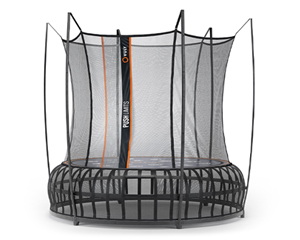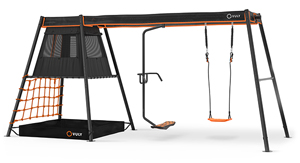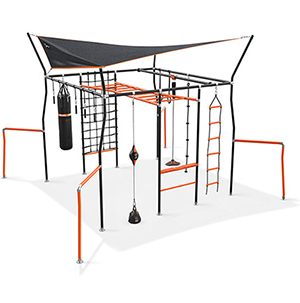
Keeping your little ones active is a great way to fuel their drive to move, learn, and discover. Ensuring your kids have an adequate amount of exercise every day is also important for promoting a happy and balanced lifestyle and teaching healthy habits.
As with the rest of the population, regular exercise also has measurable benefits for children living with cystic fibrosis. As one study reports, ‘there is a strong association between fitness and survival, and exercise programmes have shown to improve exercise tolerance and functional capacity. At present no other therapy is more effective, in maintaining health and an active lifestyle in young patients with CF, than exercise.
That said, there are some special considerations that kids with cystic fibrosis and their families should be aware of when developing an exercise plan that’s fun, engaging, and beneficial. Find out more below:
Benefits for Kids with Cystic Fibrosis
Physical
Keeping kids active can improve their physical health in more ways than you might imagine! Not only does exercise help kids develop healthy bones, muscles and joints, but it also develops their circulatory system and can support a healthy body weight. Physical activity allows kids to improve their body coordination and control. Many activities promote improved balance and posture.
Research also suggests that regular exercise has specific benefits for children with cystic fibrosis. A regular fitness routine can improve lung function by loosening mucus and causing coughing. Meanwhile, exercise can strengthen muscles, maintain healthy bones, and help with weight management.
It’s important to note that kids with cystic fibrosis sweat more, and will therefore need to pay careful attention to hydration (and ensure an adequate salt intake) when exercising. Kids with cystic fibrosis should avoid exercising during very hot weather or if they’re experiencing a fever. In addition, performing huff coughs before and during exercise can help to release mucus and make movement feel easier.
Mental
Did you know? Getting your child’s heart pumping and body moving has a long list of benefits for their mental health, just as much as their physical wellbeing.
When kids exercise, their bodies release endorphins that improve their mood and reduce stress. Feeling more physically capable also helps support children’s self-esteem and can boost their confidence.
As with the rest of the population, exercise can help kids with cystic fibrosis to regulate energy levels and alertness, making it easier to relax and concentrate when playtime is over. Exercise also regulates children’s cortisol and adrenaline levels, giving little ones a better quality sleep cycle (which we’re sure parents and guardians out there will appreciate!)
Social
Sports and other group activities encourage kids to work as a team. Exercise can teach children valuable social and developmental skills, such as sharing, turn-taking, problem-solving, negotiation, and good sportsmanship.
Having a group of peers with similar interests (even if they might be competing against each other) can offer a fun and positive social circle for your child living with cystic fibrosis. If your child joins a team sport, ensure their uniform is fitted with some extra pockets where they can store tissues for coughing!
That said, children with cystic fibrosis who have enlarged liver or spleen should avoid collision sports such as football, soccer, or basketball. It’s always worthwhile chatting with a medical professional before your child begins any new exercise or sports program, to see what’s right for them.
Four Types of Fitness Activities
The physical, mental, and social benefits of regular exercise cannot be understated. In addition, Australian health experts have recently warned against too much time spent being sedentary – whether that means kids are seated in a classroom, or watching screens at home. If you’re looking for fun ideas that will keep your kids active, check out our tips below:
Endurance activities
Endurance activities speed up kids’ heart rate and breathing and improve overall body function. Giving kids’ circulatory system a workout not only improves heart health, it gets the blood flowing to their other organs and muscles. In children with cystic fibrosis, aerobic exercise can be considered a supplement for other airway clearance techniques - although this should be discussed with a medical professional first.
Getting kids to work on their cardio helps burn body fat, lower blood pressure, reduce inflammation, raise HDL cholesterol, lower blood sugar levels, relax blood vessel walls, and like we mentioned earlier, it releases endorphins to boost their mood!
Some examples of kid-friendly endurance exercises include bike riding, jogging, skipping rope, running, dancing, swimming, sports, and aerobics. It’s important to note that kids with cystic fibrosis should consult their doctor on ways to monitor their blood sugar and adjust their carbohydrate intake, in accordance with their exercise levels. Children on insulin should know how to adjust their insulin when partaking in endurance-based or other activities.
Strength Activities
You probably already know that maintaining strong muscles is important in helping kids perform everyday tasks like walking, using stairs, raising their arms, and carrying objects around, but strength training does more than just helping muscles get stronger! Just like endurance training, strength training lowers blood sugar and encourages weight control.
Strength-based activities also stimulate bone growth, improves balance and posture, and reduces joint pain. Some fun activities to try with your kids to help improve their overall strength include jungle gyms, monkey bars, trampoline play, dancing, and pilates.
Flexibility activities
Flexibility improves kids’ range of motion and makes it easier to carry out everyday tasks such as reaching for things or bending down to tie their shoelaces. Inadequate flexibility in the muscles and tendons can lead to muscle cramps, strains, joint pain, and even injury.
It’s important to make sure that kids warm up their muscles with a few stretches before exercising, and spending some exercise sessions dedicated to improving flexibility can help maintain good flexibility in the long run. Some activities that kids can enjoy to improve their flexibility include stretching, dancing, yoga, trampolines, martial arts, and gymnastics.
Making sure your kids get their daily exercise might seem difficult at first, but don’t worry! Trying out a range of activities will help your kids figure out what they enjoy most. Choose age-appropriate activities, and refer to health guidelines or a medical expert if you’re unsure.
Incorporating physical activity into your kids’ everyday hobbies and routines will quickly make exercise a fun pastime, rather than a boring task. Best of all, regular exercise can help to manage cystic fibrosis. With these ideas, you’ll get the whole family up and moving in no time!


















































